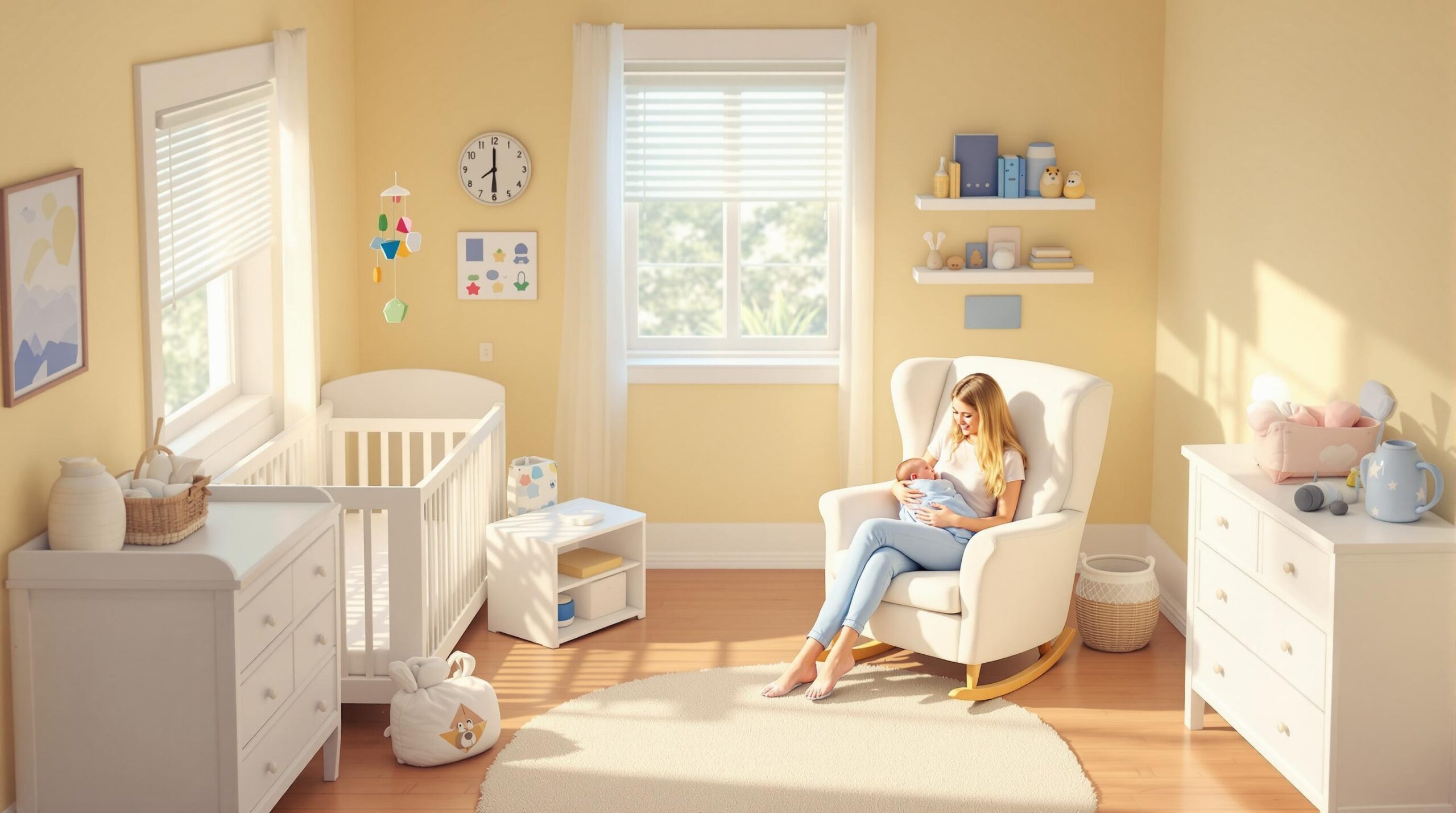Table of Contents
ToggleWelcoming a new baby into your home is an exciting and transformative experience. As parents, our top priority is ensuring our little one’s safety, comfort, and well-being. Preparing your home for this precious arrival involves more than just setting up a crib and buying diapers. It’s about creating a nurturing environment that supports your baby’s growth and development while keeping them safe from potential hazards.
Let’s dive into a comprehensive checklist that will help you prepare your home for your bundle of joy, covering everything from essential safety measures to creating a stimulating environment for your baby’s cognitive development.
Creating a Safe Haven: Essential Safety Precautions
Safety should be your primary concern when preparing your home for a baby. The Centers for Disease Control and Prevention (CDC) reports that over 12,000 children are treated daily in U.S. emergency departments for nonfatal unintentional injuries. This statistic underscores the critical importance of taking proactive steps to baby-proof your home.
Here are some crucial safety measures to implement:
Secure Furniture and Appliances
Anchor heavy furniture and appliances to the walls. This includes bookcases, dressers, and TVs. As your baby grows and becomes more mobile, they may try to climb or pull themselves up using furniture, which can lead to dangerous tip-overs if not properly secured.
Install Safety Gates
Place safety gates at the top and bottom of stairs. This prevents falls and keeps your curious crawler from accessing potentially dangerous areas. Choose gates that are sturdy and meet current safety standards. Remember to regularly check and maintain these gates as your child grows.
Window Safety
Install window guards or stops to prevent falls. According to the American Academy of Pediatrics (AAP), window falls are a leading cause of injury in young children. Ensure that windows can’t open more than 4 inches, and keep furniture away from windows to discourage climbing.
Electrical Safety
Cover all electrical outlets with safety plugs. This simple step can prevent your little one from inserting objects into outlets, reducing the risk of electrical shock. As your child grows, you may need to upgrade to more advanced outlet covers that are harder for curious toddlers to remove.
Hazardous Substance Storage
Store all hazardous substances, including cleaning supplies and medications, out of reach and preferably in locked cabinets. Even seemingly harmless items like laundry pods can be dangerous if ingested. Create a habit of immediately putting away these items after use.
The AAP recommends conducting a comprehensive home safety assessment. This involves getting down to your baby’s eye level and identifying potential hazards that might not be immediately obvious from an adult’s perspective. Preparing your home thoroughly can significantly reduce the risk of accidents and injuries.

Setting Up the Perfect Nursery
Your baby’s nursery will be their first personal space, a place where they’ll spend a significant amount of time sleeping, playing, and bonding with you. It’s crucial to create an environment that’s not only safe but also conducive to their development and comfort.
Crib Safety
The crib is the centerpiece of your nursery, and its safety is paramount. The U.S. Consumer Product Safety Commission (CPSC) provides stringent guidelines for crib safety:
- Ensure the crib meets current safety standards. Avoid using hand-me-down cribs that might not comply with updated regulations.
- Use a firm, snug-fitting mattress. There should be no gaps between the mattress and the crib sides.
- Keep the crib free of blankets, pillows, and toys to reduce the risk of suffocation.
- Position the crib away from windows, blinds, and cords to prevent entanglement or falls.
Changing Table Setup
A well-organized changing table can make diaper changes more efficient and safer. Choose a table with guardrails on all sides and keep all necessary supplies within arm’s reach. This setup allows you to keep one hand on your baby at all times during changes.
Lighting Considerations
Install dimmable lighting in the nursery. This allows for bright light during playtime and diaper changes, and softer light for feeding and bedtime routines. Consider a night light for late-night check-ins that won’t disrupt your baby’s sleep.
Temperature Control
Maintain a comfortable room temperature, ideally between 68-72°F (20-22°C). Use a room thermometer to monitor the temperature, as babies can’t regulate their body temperature as efficiently as adults.
Baby Monitor
A reliable baby monitor provides peace of mind when you’re not in the room. Modern monitors offer features like temperature sensors, two-way communication, and even movement tracking. Choose one that fits your needs and lifestyle.
The National Institute of Child Health and Human Development (NICHD) emphasizes the importance of a well-designed nursery in supporting a baby’s development. A thoughtfully arranged space can stimulate your baby’s senses and promote cognitive growth.
Supporting Your Baby’s Development Through Home Design
Creating an environment that nurtures your baby’s development is a crucial aspect of supporting developmental milestones. Understanding the stages of development can help you design spaces that grow with your child.
Developmental Stages and Environment
Jean Piaget’s theory of cognitive development outlines four stages of a child’s mental growth. While your newborn will be in the sensorimotor stage, it’s beneficial to plan for future stages:
- Sensorimotor Stage (0-2 years): Create areas with various textures and safe objects for exploration.
- Preoperational Stage (2-7 years): Include spaces for imaginative play and simple problem-solving activities.
- Concrete Operational Stage (7-11 years): Provide areas for more complex toys and educational materials.
- Formal Operational Stage (11 years and older): Design flexible spaces that can adapt to your child’s changing interests and study needs.
Stimulating Environment for Cognitive Development
The NICHD Study of Early Child Care and Youth Development highlights the significant impact of a child’s environment on their developmental milestones. Here are some ways to create a stimulating home environment:
- Use contrasting colors and patterns in the nursery to stimulate visual development.
- Incorporate different textures in toys and bedding to encourage tactile exploration.
- Play soft, soothing music to enhance auditory development.
- Create a safe floor space for tummy time and crawling exploration.
Planning for Future Needs
As your baby grows, their needs will change rapidly. Design your spaces with flexibility in mind:
- Choose furniture that can be adapted as your child grows, such as convertible cribs.
- Create storage solutions that can evolve from diaper storage to toy organization.
- Plan open spaces that can transition from crawling areas to play zones for toddlers.
By thoughtfully designing your home with your baby’s development in mind, you’re creating an environment that will support their growth and learning for years to come.
Fostering Parent-Child Bonding at Home
The home environment plays a crucial role in nurturing the bond between parent and child. The NICHD emphasizes that strong parent-child interactions significantly influence a child’s emotional and cognitive development.
Creating Bonding Spaces
Designate areas in your home specifically for bonding activities:
- A comfortable feeding area with a supportive chair for nursing or bottle-feeding.
- A cozy reading nook for storytimes.
- An open play area for interactive games and milestone-boosting activities.
Establishing Routines
Consistent routines help babies feel secure and can strengthen the parent-child bond. Create a daily schedule that includes:
- Regular feeding times
- Dedicated playtime
- A calming bedtime routine with activities like reading or singing
Skin-to-Skin Contact
Skin-to-skin contact is crucial for newborns, promoting bonding and regulating the baby’s body systems. Create opportunities for this contact throughout the day, not just during feeding times.
Parenting Support
The U.S. Department of Health and Human Services (HHS) offers resources for parenting support. Consider joining local parenting groups or classes to connect with other parents and gain additional guidance.
Maintaining a Healthy and Hygienic Home Environment
A clean and healthy home is essential for your baby’s well-being. The Environmental Protection Agency (EPA) provides guidelines for maintaining a healthy home environment:
Air Quality
Ensure proper ventilation in your home, especially in the nursery. Use air purifiers if needed, and avoid smoking or using harsh chemicals indoors.
Cleaning Routine
Establish a regular cleaning schedule, focusing on areas your baby frequents:
- Vacuum carpets and mop floors regularly
- Wash bedding weekly in hot water
- Clean and disinfect changing areas daily
- Regularly wash and sanitize toys
Storage Solutions
Keep baby supplies and toys in clean, dry areas to prevent mold growth and dust accumulation. Use closed containers for storage when possible.
Baby’s Hygiene Routine
The Centers for Disease Control and Prevention (CDC) recommends establishing a consistent hygiene routine for your baby:
- Regular baths (not necessarily daily for newborns)
- Proper diaper changing procedures
- Regular nail trimming
- Gentle cleaning of the face and neck folds
Beyond the Basics: Additional Tips for New Parents
Preparing for a baby involves more than just the immediate necessities. Here are some additional considerations to ensure you’re fully prepared:
Emergency Preparedness
The American Red Cross suggests having a well-stocked first aid kit and an emergency contact list readily available. Include your pediatrician’s number, poison control, and emergency services.
Professional Baby-Proofing Services
Consider hiring a professional baby-proofing service for a comprehensive safety assessment of your home. They can identify potential hazards you might overlook and provide specialized solutions.
Stay Informed About Product Safety
Regularly check for product recalls and safety updates. The CPSC website is an excellent resource for this information.
Cognitive Stimulation
Boosting infant brain development through various activities is crucial. Create an environment rich in age-appropriate stimuli, such as high-contrast images for newborns or soft toys with different textures for older babies.
Self-Care for Parents
Remember to take care of yourself too. Create a space in your home where you can relax and recharge. A well-rested parent is better equipped to care for their baby.
Preparing your home for a baby is a journey filled with love, excitement, and a fair share of challenges. By following this comprehensive checklist, you’re laying the foundation for a safe, nurturing environment where your baby can thrive. Remember, every family’s needs are unique, so feel free to adapt these suggestions to fit your specific situation. The goal is to create a home where both you and your baby feel safe, comfortable, and ready to embark on the beautiful adventure of parenthood.
Sources:
American Academy of Pediatrics (AAP)
Centers for Disease Control and Prevention (CDC)
U.S. Consumer Product Safety Commission (CPSC)
National Institute of Child Health and Human Development (NICHD)
Environmental Protection Agency (EPA)
American Red Cross
National Safety Council (NSC)
U.S. Department of Health and Human Services (HHS)
NICHD Study of Early Child Care and Youth Development













This Post Has One Comment
Pingback: Building a Baby Registry: Essentials You’ll Actually Use – GuideForKids
Comments are closed.